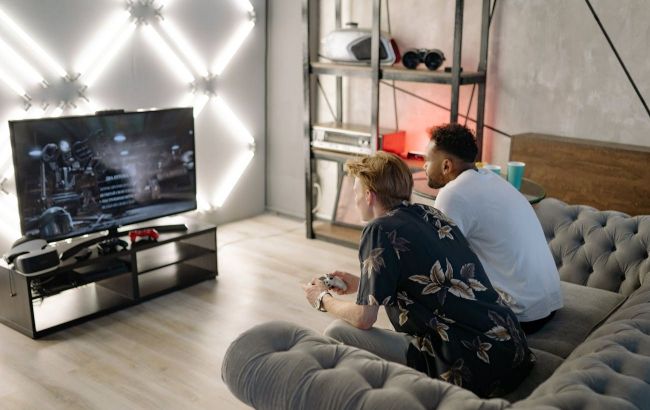How to choose TV for perfect gaming experience on PlayStation and Xbox Series
 How to choose a TV for gaming on PlayStation 5 and Xbox Series X|S (Illustrative photo: Pexels)
How to choose a TV for gaming on PlayStation 5 and Xbox Series X|S (Illustrative photo: Pexels)
A common issue for many PlayStation 5 and Xbox Series X/S owners is the lack of a suitable television that can fully unleash the power and capabilities of these consoles. To choose a good model, one needs to understand the new technologies of the consoles and the specific features of the screens.
Gamegatehq reveals insights on what to consider when selecting a television for PlayStation and Xbox Series gaming.
What are the advantages of PlayStation 5 and Xbox Series X/S
Resolution up to 8K
The next-generation consoles, PlayStation 5 and Xbox Series X, support games with a resolution of up to 7680 x 4320 pixels. However, there are currently few titles available with such image clarity, so it's not advisable to prioritize this benchmark.
In televisions, 8K resolution is only found in very high-end models with screens larger than 75 inches. In other words, this is more of a future-proofing consideration.
Unfortunately, the trimmed-down version, Xbox Series S, does not offer this feature.
4K 120Hz mode
The PS5 and Xbox Series X are the first consoles to support 4K displays with a refresh rate of 120 Hz (with the Series S limited to 1440p). This essentially represents the gold standard that developers strive for.
However, such graphics significantly increase the load on the device, which means that many games currently require sacrificing image quality for smoother performance. Players often find themselves choosing between 4K at 60 Hz or FHD at 120 Hz.
HDR support
HDR (High Dynamic Range) technology offers an extended dynamic range, allowing the video signal to carry much more information about brightness and color for each pixel. This results in a rich image on screen, featuring vibrant sunsets, lush sea surfaces, striking lighting effects, and more.
VRR support
Variable Refresh Rate (VRR) addresses the issue of tearing, which occurs when the frame rate on the screen does not match the output frame rate of the graphics processor. Without VRR, the image can appear fragmented, as if certain connecting elements have fallen out of sync. This is particularly critical for action genres.
ALLM support
Auto Low Latency Mode (ALLM) is designed to detect the console's connection to the television and automatically switch it into game mode. This reduces latency between input from the controller and the corresponding action on the screen. Like VRR, this technology is implemented with HDMI 2.1 in mind.
What to pay attention to when choosing a TV for PS5 and Xbox Series X/S gaming
In addition to the features mentioned above, several basic characteristics of screens are also crucial, and there are quite a few potential pitfalls to consider.
Resolution and screen size
Resolution refers to the number of pixels on a television screen. The more pixels there are, the sharper and more detailed the image will be. When selecting a television for the PlayStation 5 and Xbox Series X, look for models that support 4K, also known as Ultra HD. For the Xbox Series S, a budget-friendly option like FHD is sufficient.
The choice of screen size depends on the television's placement, room size, and your viewing habits. Generally, the larger the screen, the further away you should sit to avoid straining your neck and to prevent seeing the notorious pixel grain.
To determine the recommended minimum distance from the screen, multiply the diagonal size by 1.2. For example, if you have a 50-inch television, you should sit approximately 60 inches (or 1.5 meters) away. For a 55-inch screen, the distance should be about 1.7 meters, for a 65-inch screen, around 2 meters, and for a 75-inch screen, approximately 2.3 meters.
Panel type
IPS
The most popular and affordable LED matrix offers good color reproduction and a contrast ratio of up to 1500:1. However, it lacks deep black levels, which means that in dark scenes, backlighting may be visible. Viewing angles are decent, and the response time is average.
VA
The more expensive LED variant offers a more contrast-rich image and deeper black levels. Its response time can be either higher or lower than that of IPS displays, but typically, the viewing angles and color reproduction are slightly inferior.
QLED
This matrix technology is based on quantum dots with backlighting, providing a very bright and vibrant image with good viewing angles, as well as accurate white and black levels. However, similar to IPS displays, backlighting may be visible in dark scenes.
OLED
The matrix based on organic dots doesn't require backlighting as they emit light themselves. This results in the highest contrast ratio and infinitely deep blacks. The response time is instantaneous, and both brightness and viewing angles surpass those of IPS panels. This technology represents the absolute top tier, but the price is astronomical.
There are also other matrices found only in specific television lineups, such as LG's NanoCell or Sony's Triluminos. Both are based on quantum dots and do not have significant differences from QLED technology.
Backlight type
Backlighting is irrelevant for OLED displays, but it is crucial for other matrix types, as it directly affects the brightness and color reproduction of the television.
Edge LED refers to backlighting positioned around the edges of the panel. In this design, LEDs are distributed along the perimeter of the screen, and the back is coated with a reflective layer. The advantage of this technology is the thinness of the panel, while the downside is that it can cause glare along the edges, which is particularly noticeable in dark scenes.

